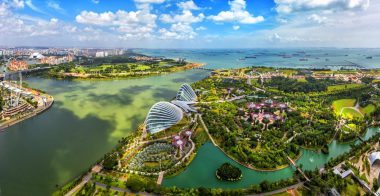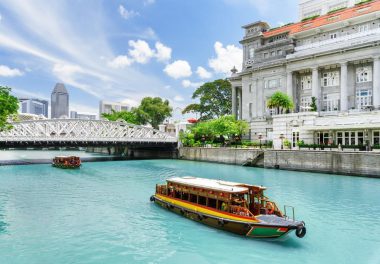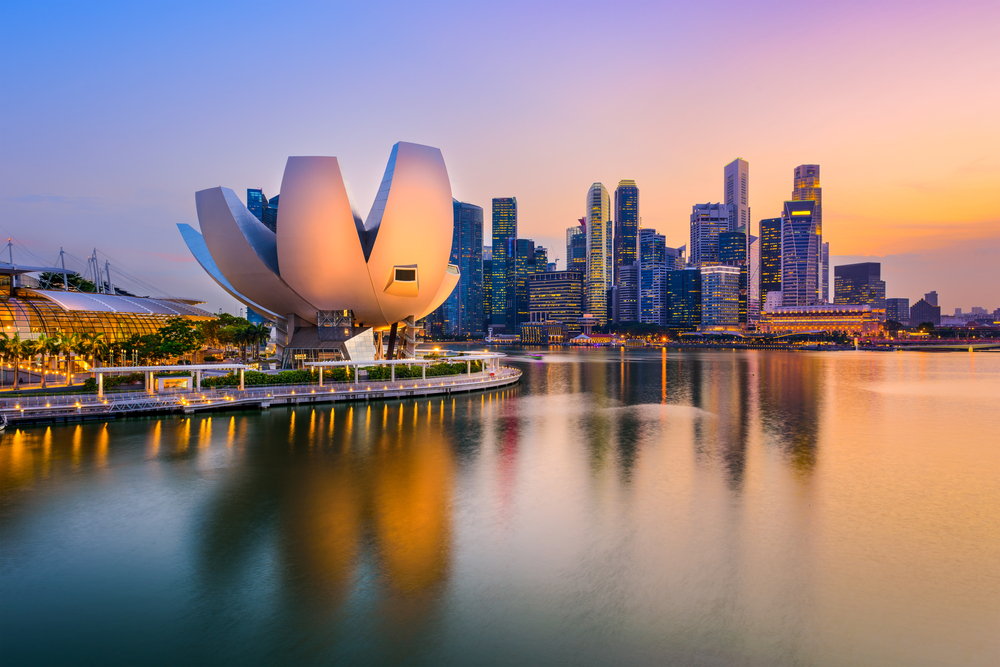
Tradition and modernity in Singapore

Travel information Singapore
| Capital | Singapore |
|---|---|
| Form of government | Republic Parliamentary illiberal democracy |
| Currency | Singapore Dollar (SGD) |
| Area | approx. 719 km² |
| Population | approx. 5,607,300 (2016 est.) |
| Languages | Tamil, Malay, Chinese and English |
| Power supply | 230 volts, 50 Hz |
| Calling code | +65 |
| Time zone | UTC+8 |
Singapore: The 7 most important sights
Singapore, the dazzling city of lions, is a fascinating destination that combines modernity and tradition in perfect harmony.
From impressive architecture to lush green spaces, the city offers numerous sights that delight visitors from all over the world.
Here are the top seven must-see sights on your visit to Singapore.
1. Marina Bay Sands
Marina Bay Sands is one of Singapore’s most recognizable landmarks, offering stunning views of the city skyline.
The luxury hotel is also home to a casino, a shopping mall and the famous rooftop infinity pool.
2. Gardens by the Bay
Gardens by the Bay is a futuristic park that delights with its giant supertrees and impressive greenhouses such as the Flower Dome and the Cloud Forest.
Especially at night, the park shines in a spectacular play of light.
3. Sentosa Iceland
Sentosa Iceland is a popular leisure and recreation area in Singapore.
Here you will find attractions such as the Universal Studios theme park, the SEA Aquarium and beautiful beaches to relax.
4. Merlion Park
Merlion Park is home to the iconic Merlion statue, a landmark of Singapore.
The statue, which has the head of a lion and the body of a fish, spits water into Marina Bay and provides a fantastic photo opportunity.
5. Chinatown
Chinatown is a lively neighborhood full of culture and history.
Here you will find traditional shops, temples such as the Buddha Tooth Relic Temple and a variety of restaurants offering delicious Chinese cuisine.
6. Orchard Road
Orchard Road is Singapore’s shopper’s paradise.
This famous street is lined with luxury shopping malls, boutiques, and restaurants.
Here you can shop to your heart’s content and discover the latest fashion trends.
7. Singapore Botanic Gardens
The Singapore Botanic Gardens is a UNESCO World Heritage Site and a tranquil retreat in the middle of the bustling city.
The garden is home to an impressive collection of orchids and offers many quiet corners to relax.
The 3 most important museums in Singapore
1. National Museum of Singapore
The National Museum of Singapore is the oldest museum in the city and offers an extensive collection on Singapore’s history.
It features interactive exhibitions that shed light on the cultural and social development of the city. Address: 93 Stamford Road, Singapore 178897 Opening hours: Daily 10:00 a.m. – 7:00 p.m. Admission: 15 SGD
2. ArtScience Museum
The ArtScience Museum is known for its unique exhibitions that combine art, science, culture, and technology.
The iconic architecture of the museum in the shape of a lotus flower is a highlight in itself. Address: 6 Bayfront Avenue, Singapore 018974 Opening hours: Daily 10:00 a.m. – 7:00 p.m. Admission: 19 SGD
3. Asian Civilisations Museum
The Asian Civilisations Museum showcases the cultural diversity of Asia and features an impressive collection of artifacts from China, Southeast Asia, South Asia, and the Islamic Middle East. Address: 1 Empress Place, Singapore 179555 Opening hours: Daily 10:00 a.m. – 7:00 p.m. (Friday until 9:00 p.m.) Admission: 20 SGD
Where to stay in Singapore
Luxury Hotels: Marina Bay Sands
Marina Bay Sands is the ultimate luxury hotel in Singapore, known for its iconic rooftop infinity pool, luxurious rooms and unparalleled views of the city skyline.
It also offers a casino, first-class restaurants and a shopping mall.
4-star hotel: Hotel Jen Orchardgateway
Centrally located on Orchard Road, Hotel Jen Orchardgateway offers modern rooms, a rooftop infinity pool and a relaxed atmosphere.
It is ideal for travelers who appreciate comfort and a central location.
3-star hotel: YOTEL Singapore Orchard Road
YOTEL Singapore offers compact yet stylish rooms with high-tech amenities in a superb location on Orchard Road.
The hotel is known for its futuristic design and offers good value for money.
Budget Hotel: Hotel 81 Chinatown
Hotel 81 Chinatown offers affordable accommodation near the vibrant Chinatown district.
It’s a great choice for travelers on a budget looking for a central location and basic amenities.
Popular Restaurants in Singapore
1. Burnt Ends
Burnt Ends is a modern Australian BBQ restaurant known for its excellent meat quality and open fire.
The restaurant has a Michelin star and offers a creative menu in a relaxed atmosphere.
2. Jumbo Seafood
Jumbo Seafood is famous for its chili crab, a dish that is considered the unofficial national dish of Singapore.
The fresh seafood and lively atmosphere make it a must-visit for any visitor.
3. Hawker Chan
Hawker Chan is the cheapest Michelin-starred restaurant in the world and is known for its delicious Soya Sauce Chicken Rice.
Here you can enjoy authentic Singaporean street food at affordable prices.
4. Odette
Odette is a multi-award-winning French restaurant in Singapore known for its innovative cuisine and top-notch service.
It offers an elegant ambience and an exquisite menu that will delight gourmets.
FAQ: Important questions about Singapore
When is the best time to visit Singapore?
Singapore can be visited all year round as it has a tropical climate with warm temperatures and high humidity.
However, the best time to visit is from February to April, when the weather is a bit cooler and drier.
What is the best way to get around Singapore?
Singapore has an excellent public transport system that includes MRT (Mass Rapid Transit) and buses.
Taxis and ride-sharing services such as Grab are also widely available and convenient.
How expensive is Singapore?
Singapore is relatively expensive compared to other Asian cities.
Prices for hotels, food, and activities can be high, but there are plenty of cheap options, especially in the hawker centers.
What currency is used in Singapore?
In Singapore, the Singapore dollar (SGD) is used.
Credit cards are accepted in most shops and restaurants, but it is advisable to have some cash with you as well.
Is there a City Card in Singapore?
Yes, the Singapore Tourist Pass offers unlimited travel on public transport for 1, 2 or 3 days and is a good option for tourists who want to explore the city.
What are typical souvenirs from Singapore?
Typical souvenirs from Singapore are orchid products, merlion figures, laksa paste and traditional batik fabrics.
Kaya jam, a sweet coconut jam, is also a popular souvenir.
Is Singapore a safe destination?
Yes, Singapore is considered one of the safest cities in the world.
The crime rate is very low, and the city is well organized and clean.
Are there beaches in Singapore?
Yes, Singapore has some beaches, especially on Sentosa Iceland.
The beaches are clean and well-maintained, but do not offer top-notch water quality due to the proximity to shipping routes.
Bibliography
- Information about attractions and museums: Visit Singapore
- Google Maps
Article updated on August 16, 2025


